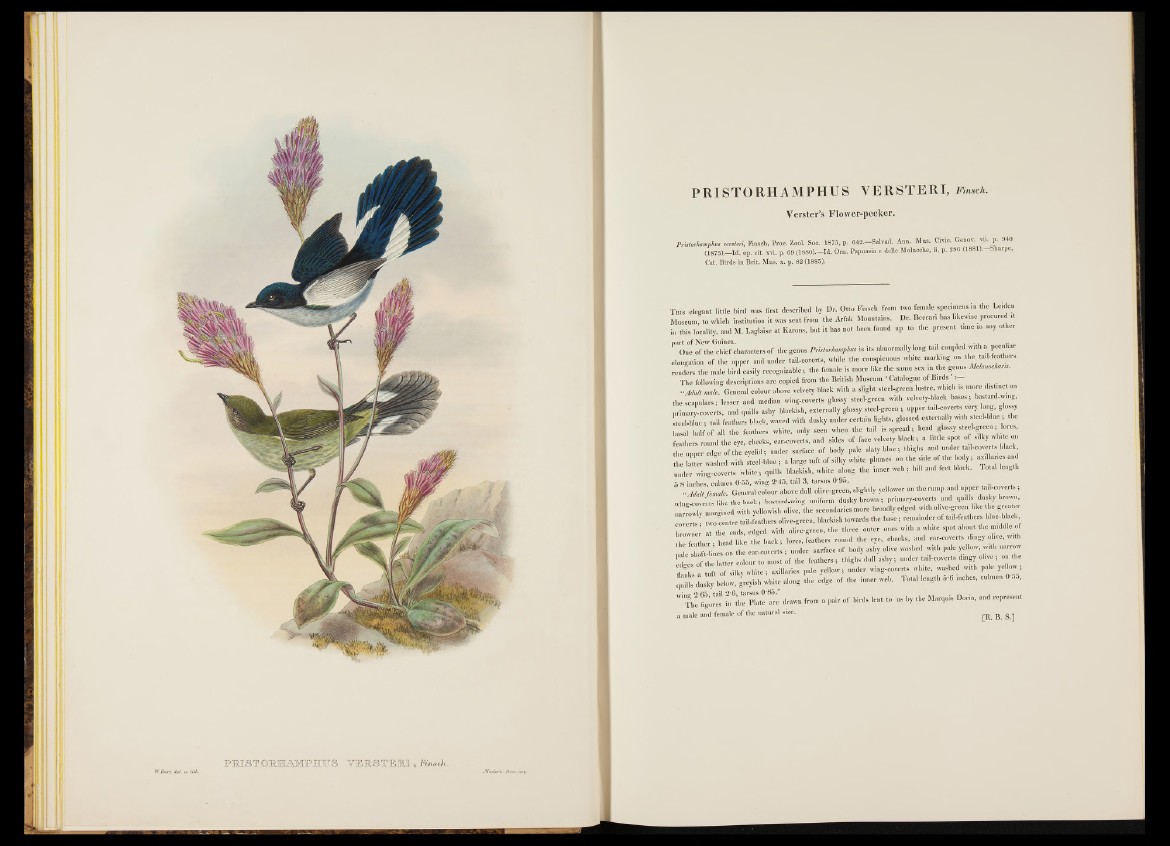
PRISTORHAMPHUS VERSTERI, Fmsch.
Verster’s Flower-pecker.
Prhtorhamphm vereteri, Fmsch, Proo. Zool. Soc. 1875, p. 642.-Salvad. Ann. Mus. a™ . Genov. ■ p. 9 «
(1875M j d . op. cit. xvi. p. 69 (1880).—Id. Om. Papuasia e ddle Molucche, u. p. 286 (1881).—bkarpe,
Cat. Birds in Brit. Mus. x. p. 82 (1885).
■ms d e n o t little bird was first described f e Dr. Otto Finsch from two female specimens in the Leiden
fuseum, to which institution it was sent from the Arfak Mountains. D r. Beccari has likewise procured g
, this locality, and M. Laglaise a t Karons, but it has not been found np to the present time in any other
a rt of New Guinea. r , . , ..
One of the chief characters of the genus PristmUmphw is its abnormally long tail coupled with a peculiar
longation of the upper and under tail-eoverts, while the conspicuous white marking on th e¡tal-feath ers
enders the male bird easily recognizable; the female is more like the same sex in the genus-Melamcham.
The following descriptions are copied from the British Museum I Catalogue o f Birds
■ H male. General colour above velvety black with a slight steel-green lustre, which is more distinct on
be scapulars; lesser and median wing-coverts glossy steel-green with velvety-black bases; bastard-wing,
K o a ry coverts, and quills ashy blackish, externally glossy steel-green ; upper tad-coverts very long, glossy
teel-blue ; tail-feathers black, waved with d u sk , under certain lights, glossed externally with steel-blue;
insal half of all the feathers white, only seen when the tail is sp re a d ; head glossy steel-green; lores,
bathers round the eye, cheeks, ear-coverts, and sides of faee velvety black; a little spot of silky white on
he upper edge of the eyelid; under surface o f body pale slaty blue ; thighs amilouder tail-covert, black
he latter washed with steel-blue; a large tuft o f silky white plumes on the side o f the body; ¡— I
mder wing-coverts white; quills blackish, white along the inner web; bill and feet black. Total length
5-8 inches, culmen 0'55, wing 2'45, tail 3, tarsus 0-95.
“ Adult female. General colour above dull olive-green, slightly yellower on the rump and upper taiUcoverts;
wing-coverts like the back; bastard-wing uniform dusky brown ; primary-coverts and quills dusky brown,
narrowly margined with yellowish olive, the secondaries m ore broadly edged with olive-green like he greater
coverts two centre tail-feathers olive-green, blackish towards the base; remainder o f tail-feathers bine-black
browner at the ends, edged with olive-green, the three outer ones with a white spot about the middle of
the feather - head like the hack ; lores, feathers round the eye, cheeks, and ear-coverts dingy olive, with
pale shaft-lines on the ear-coverts ; under surface o f body ashy olive washed with pale yellow, with narrow
edges o f the latter colour to most o f the feathers ; thighs dull a sh y ; under tail-eovertsdingy olive; on the
flanks a tuft o f silky w h ite ; axillaries pale yellow; under wing-coverts white, washed with pale yellow
quills dusky below, greyish white along the edge o f the inner web. Total length 5-6 inches, culmen 0 55,
H H w B B B ■ <*>» I of H i™t 1 1 ■ ■ I**- »o "P"“"1